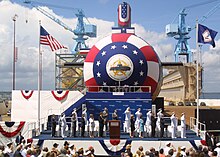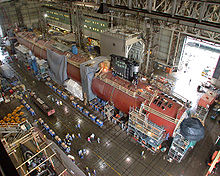Virginia class submarine
From Wikipedia, the free encyclopedia
 USS Virginia |
|
| Class overview | |
|---|---|
| Name: | Virginia |
| Builders: | General Dynamics Electric Boat Newport News Shipbuilding and Drydock Company |
| Operators: | |
| Preceded by: | Seawolf class attack submarine Los Angeles class attack submarine |
| Cost: | $1.8 billion per unit 2009[1] |
| Built: | 2000 – present |
| In commission: | 2004 – present |
| Building: | 3 |
| Planned: | 30 |
| Completed: | 7 |
| Active: | 7 |
| General characteristics | |
| Type: | Attack submarine |
| Displacement: | 7,900 metric tons (7,800 long tons) |
| Length: | 377 ft (115 m) |
| Beam: | 34 ft (10 m) |
| Propulsion: | S9G reactor |
| Speed: | +25 knots (29 mph; 46 km/h) |
| Range: | unlimited except by food supplies |
| Test depth: | +800 ft (240 m) |
| Complement: | 135 (15:120) |
| Armament: | 12 × VLS (BGM-109 Tomahawk cruise missile) & 4 × 533mm torpedo tubes (Mk-48 torpedo) 38x torpedoes & missiles |
| Notes: | Ships in class include: Virginia, Texas, Hawaii, North Carolina, New Hampshire, New Mexico, Missouri, California, Mississippi, Minnesota, North Dakota, John Warner |
Contents[hide] |
[edit] Innovations
The Virginia class incorporates several innovations not previously incorporated into other submarine classes.[1][edit] Photonics Masts
Instead of a traditional periscope, the class utilizes a pair of telescoping photonics masts[1] located outside the pressure hull. Each mast contains high-resolution cameras, along with light-intensification and infrared sensors, an infrared laser rangefinder, and an integrated Electronic Support Measures (ESM) array. Signals from the masts' sensors are transmitted through fiber optic data lines through signal processors to the control center. Visual feeds from the masts are displayed on LCD interfaces in the command center.[edit] Propulsion
The class also makes use of pump-jet propulsors, which significantly reduces the risks of cavitation, allowing for quieter and faster operations.[edit] Improved sonar systems
The Virginia class submarines are equipped with a bow-mounted spherical active/passive sonar array, a wide aperture lightweight fiber optic sonar array (three flat panels mounted low along either side of the hull), as well as two high frequency active sonars mounted in the sail and keel (under the bow). The submarines are also equipped with a low frequency towed sonar array and a high frequency towed sonar array.[2]The USS California will be the first Virginia-class submarine with the advanced electromagnetic signature reduction system built into it, but this system will be retrofitted into the other submarines of the class.[3]
[edit] Construction and controversy
The Virginias were intended, in part, as a cheaper ($1.8 billion vs, $2.8 billion) alternative to the Seawolf class sumbarines, whose production run was stopped after just three boats had been completed. To reduce costs, the Virginia-class submarines use many "commercial off-the-shelf" (or COTS) components, especially in their computers and data networks. In practice, they actually cost less than $1.8 billion (in fiscal year 2009 dollars) each, due to improvements in shipbuilding technology.[citation needed]In hearings before both House of Representatives and Senate committees, the Congressional Research Service and expert witnesses testified that the current procurement plans of the Virginia class — one per year at present, accelerating to two per year beginning in 2012 — would result in high unit costs and (according to some of the witnesses and to some of the committee chairmen) an insufficient number of attack submarines.[4] In a March 10, 2005 statement to the House Armed Services Committee, Ronald O'Rourke of the CRS testified that, assuming the production rate remains as planned, "production economies of scale for submarines would continue to remain limited or poor."[5]
The Virginia class is built through an industrial arrangement designed to keep both GD Electric Boat and Newport News Shipbuilding and Drydock Company (the only two U.S. shipyards capable of building nuclear-powered vessels) in the submarine-building business.[6] Under the present arrangement, the Newport News facility builds the stern, habitability and machinery spaces, torpedo room, sail and bow, while Electric Boat builds the engine room and control room. The facilities alternate work on the reactor plant as well as the final assembly, test, outfit and delivery.
O’Rourke wrote in 2004 that, "Compared to a one-yard strategy, approaches involving two yards may be more expensive but offer potential offsetting benefits."[7] Among the claims of "offsetting benefits" that O'Rourke attributes to supporters of a two-facility construction arrangement is that it "would permit the United States to continue building submarines at one yard even if the other yard is rendered incapable of building submarines permanently or for a sustained period of time by a catastrophic event of some kind", including an enemy attack.
In order to get the submarine's price down to $2 billion per submarine in FY-05 dollars, the Navy instituted a cost-reduction program to shave off approximately $400 million in costs off each submarine's price tag. The project was dubbed "2 for 4 in 12," referring to the Navy's desire to buy two boats for $4 billion in FY-12. Under pressure from Congress, the Navy opted to start buying two boats a year earlier, in FY-11, meaning that officials would not be able to get the $2 billion price tag before the service started buying two submarines per year. However, program manager Dave Johnson said at a conference on March 19, 2008, that the program was only $30 million away from achieving the $2 billion price goal, and would reach that target on schedule.[8]
In December 2008, the Navy signed a $14 billion contract with General Dynamics and Northrop Grumman to supply eight submarines. The contractors will deliver one submarine in each of fiscal 2009 and 2010, and two submarines on each of fiscal 2011, 2012 and 2013.[9] This contract will bring the Navy's Virginia-class fleet to 18 submarines. And in December 2010, the United States Congress passed a defense authorization bill that expanded production to two subs per year.[10]
On 21 June 2008, the Navy christened the New Hampshire (SSN-778), the first Block II submarine. This boat was delivered eight months ahead of schedule and $54 million under budget.[11] Block II boats are built in four sections, compared to the ten sections of the Block I boats. This enables a cost saving of about $300 million per boat, reducing the overall cost to $2 billion per boat and the construction of two new boats per year. Beginning in 2010, new submarines of this class will include a software system that can monitor and reduce their electromagnetic signatures when needed.[12]
In September 2010, it was found that urethane tiles, applied to the hull to dampen internal sound and absorb rather than reflect sonar pulses, were falling off while the subs were at sea.[13]
Ross Babbage has called on Australia to buy or lease a dozen Virginia class submarines from the United States.[14]
[edit] Tango Bravo
Because of the slow rate of Virginia production, the Navy entered into a program with DARPA to overcome Technology Barriers (TB or Tango Bravo) to lower the cost of attack submarines so that more could be built to keep up the size of the fleet.[15]These include:[16]
- Propulsion concepts not constrained by a centerline shaft.
- Externally stowed and launched weapons (especially torpedoes).
- Conformal alternatives to the existing spherical sonar array.
- Technologies that eliminate or substantially simplify existing submarine hull, mechanical and electrical systems.
- Automation to reduce crew workload for standard tasks
[edit] Specifications
- Builders: GD Electric Boat and Northrop Grumman Newport News
- Length: 377 ft (114.91 m)
- Beam: 34 ft (10.36 m)
- Displacement: 7,800 long tons (7,900 t)
- Payload: 40 weapons, special operations forces, unmanned undersea vehicles, Advanced SEAL Delivery System (ASDS)
- Propulsion: The S9G nuclear reactor
- Maximum diving depth: greater than 800 ft (244 m)
- Speed: 25+ knots[17]
- Planned cost: about US$1.65 billion each (based on FY95 dollars, 30-ship class and two ship/year build-rate, which has not yet been authorized)
- Actual cost: about $1.8 billion each (as of 2009)[18]
- Crew: 120 enlisted and 14 officers
- Armament: 12 VLS & four torpedo tubes, capable of launching Mark 48 torpedoes, UGM-109 Tactical Tomahawks, Harpoon missiles[19] and the new advanced mobile mine when it comes available.
[edit] Boats
[edit] Block I
- USS Virginia (SSN-774), commissioned and in service.
- USS Texas (SSN-775), commissioned and in service.
- USS Hawaii (SSN-776), commissioned and in service.
- USS North Carolina (SSN-777), commissioned and in service.[20]
[edit] Block II
- USS New Hampshire (SSN-778), commissioned and in service.[21]
- USS New Mexico (SSN-779) commissioned and in service.[22][23]
- USS Missouri (SSN-780), commissioned and in service.[24]
- California (SSN-781), launched November 14, 2010, and is scheduled to be commissioned on October 29, 2011 in Norfolk, Virginia.[25]
- Mississippi (SSN-782), keel laid down June 9, 2010, and expected to be delivered in February 2012.[26]
- Minnesota (SSN-783), named July 15, 2008, keel laid down May 20, 2011 and expected to be delivered in April 2013.[27]
[edit] Block III
SSN-784 through approximately SSN-791 are planned to make up the Third Block or "Flight" and began construction in 2009. Block III subs will feature a revised bow, including some technology from Ohio class SSGNs.[28][29]- North Dakota (SSN-784), named July 15, 2008[27] and is contracted for delivery in August 2014.
- John Warner (SSN-785), named January 8, 2009[30] and is contracted for delivery in August 2015.
- SSN-786, ordered
- SSN-787, ordered
- SSN-788
- SSN-789
- SSN-790
- SSN-791
[edit] Block IV
[edit] Block V
Block V subs may incorporate the Virginia Payload Module (VPM), which would give guided-missile capability when the SSGNs are retired from service.[31][edit] See also
Anda baru saja membaca artikel yang berkategori Militer
dengan judul Virginia class submarine. Anda bisa bookmark halaman ini dengan URL http://blognyaifal.blogspot.com/2011/10/virginia-class-submarine.html. Terima kasih!
Ditulis oleh:
Anonim -









Belum ada komentar untuk "Virginia class submarine"
Posting Komentar
Terima Kasih bagi yang sudah berkomentar,dimohon sering-sering berkunjung ya!